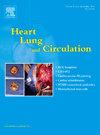Interplay of Age and Risk Factor Control Upon Coronary Atheroma Progression
IF 2.2
4区 医学
Q2 CARDIAC & CARDIOVASCULAR SYSTEMS
引用次数: 0
Abstract
Background & Aim
The extent and composition of coronary plaque, and its progression differ with patients’ age. The interplay of patient’s age with respect to risk factor control, upon atheroma progression has not been evaluated. We tested the hypothesis that risk factor control modulates the association between age and coronary atheroma progression.
Method
We performed a post hoc pooled analysis of data from 10 prospective, randomised trials involving serial coronary intravascular ultrasonography (IVUS) (n=5,823). The percent atheroma volume (PAV) was calculated as the proportion of the entire vessel wall occupied by atherosclerotic plaque.
Results
Mean overall age was 58±9 years (28% women). In a fully adjusted multivariable analysis (following adjustment of sex, body mass index, systolic blood pressure [SBP], smoking, high-density lipoprotein and low-density lipoprotein [LDL]-cholesterol, triglyceride levels, peripheral vascular disease, diabetes mellitus, trial, region, and baseline PAV), an increase in age by one standard deviation was linked with PAV progression (β-estimate 0.097; 95% confidence interval 0.048–0.15; p<0.001). In patients with good risk factor control (LDL-cholesterol <1.8 mmol/L and SBP <130 mmHg), increasing age remained associated with PAV progression (0.123; 0.014–0.23; p=0.027). Lower effect sizes for the association of age with PAV progression were observed for patients with partial control of LDL-cholesterol and SBP and were not significantly associated with PAV progression when both LDL-cholesterol and SBP were not controlled (0.099; 0.032–0.167; p=0.004 and 0.042; −0.056 to 0.14; p=0.40, respectively).
Conclusions
Patient age is directly associated with coronary atheroma progression independently of traditional cardiovascular risk factors. In the setting of poor risk factor control, the influence of age on coronary artery disease progression is attenuated.
年龄和危险因素控制对冠状动脉粥样硬化进展的相互作用
背景和目的:冠状动脉斑块的范围和组成及其进展随患者年龄而异。目前尚未评估患者年龄与危险因素控制、动脉粥样斑块进展之间的相互影响。我们检验了风险因素控制调节年龄与冠状动脉粥样斑块进展之间关系的假设:我们对 10 项前瞻性随机试验的数据进行了事后汇总分析,这些试验涉及连续冠状动脉血管内超声成像(IVUS)(n=5,823)。动脉粥样斑块体积百分比(PAV)的计算方法是动脉粥样硬化斑块占整个血管壁的比例:平均年龄为 58±9 岁(女性占 28%)。在完全调整后的多变量分析中(在调整性别、体重指数、收缩压[SBP]、吸烟、高密度脂蛋白和低密度脂蛋白胆固醇、甘油三酯水平、外周血管疾病、糖尿病、试验、地区和基线 PAV 后),年龄增加一个标准差与 PAV 的进展有关(β-估计值 0.097;95% 置信区间 0.048-0.15;p 结论:患者年龄与冠状动脉粥样硬化斑块的进展直接相关:患者年龄与冠状动脉粥样斑块的进展直接相关,而与传统的心血管风险因素无关。在危险因素控制不佳的情况下,年龄对冠状动脉疾病进展的影响会减弱。
本文章由计算机程序翻译,如有差异,请以英文原文为准。
求助全文
约1分钟内获得全文
求助全文
来源期刊

Heart, Lung and Circulation
CARDIAC & CARDIOVASCULAR SYSTEMS-
CiteScore
4.50
自引率
3.80%
发文量
912
审稿时长
11.9 weeks
期刊介绍:
Heart, Lung and Circulation publishes articles integrating clinical and research activities in the fields of basic cardiovascular science, clinical cardiology and cardiac surgery, with a focus on emerging issues in cardiovascular disease. The journal promotes multidisciplinary dialogue between cardiologists, cardiothoracic surgeons, cardio-pulmonary physicians and cardiovascular scientists.
 求助内容:
求助内容: 应助结果提醒方式:
应助结果提醒方式:


